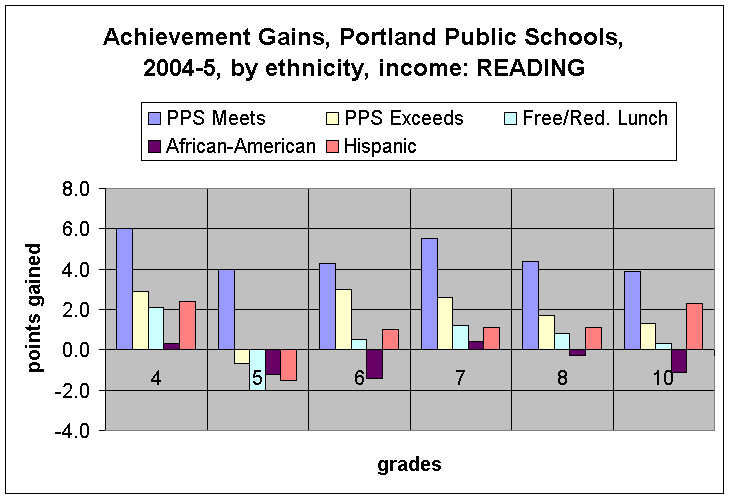
Achievement Gains, Portland Public Schools, 2004-5, by ethnicity, income
READING PPS Avg PPS Exceeds F/R Lunch African Am. Hispanic Grade exceeds exceeds Exceeds 4 6.0 2.9 2.1 0.3 2.4 5 4.0 -0.7 -2.0 -1.2 -1.5 6 4.3 3.0 0.5 -1.4 1.0 7 5.5 2.6 1.2 0.4 1.1 8 4.4 1.7 0.8 -0.3 1.1 10 3.9 1.3 0.3 -1.1 2.3 MATH Grade PPS Avg PPS exceeds F/R Lunch Af. Am HIsp. 4 7.1 4.5 2.6 1.4 1.6 5 7.7 5.9 4.2 3.8 3.7 6 2.6 0.7 -1.3 -2.7 0.1 7 4.6 1.9 1.4 -0.8 2.9 8 4.1 2.6 1.7 0.0 2.5 10 1.6 -1.1 -1.7 -0.8 -1.6


Notes: These tables and graphs were compiled in 2006 from data on the Portland Public Schools website, in the section for "Testing". See http://www.pps.k12.or.us/depts-c/rne/results/perfGrowth.php?school=distr&resultYear=2005 . Numbers from several different tables were combined and a graphing program was used to display the numbers.
The data for "gains" subtracts student achievement test scores for each student in 2004 from the achievement test score for the same student in 2005 except in the case of tenth grade gains. As there is no ninth grade test, the scores of students from 2003, when they were in the eighth. grade, are subtracted from their scores for 2005 when they were in the tenth grade. Students taking the test are grouped by ability in five groups: "Very Low, Low, Nearly Meets, Meets, and Exceeds."
The graph compares the gains for students who exceeded the benchmarks with gains for students who met benchmarks. In addition, score gains for Free and Reduced Lunch, African American, and Hispanic American students who exceeded benchmarks in the previous test are shown.
The graph represents a "snapshot," not a trend. It does NOT trace gains from third grade to tenth grade for a single cohort of students. It compares the gains achieved by students in different grades who all took one test last year and another test one or two years previously. Changes occurred in 2003-2004 and 2004-2005 in which students should be included in test results due to the No Child Left Behind Act. Also, beginning in 2003-2004, students in grades 4, 6 and 7 took Oregon State Assessments as opposed to district tests (PALT). State performance standards for these grades will not apply until 2005-2006, however, so the old PPS cut points were used for this report.
The graphs only represent student learning for the curriculum that was included in the test and may not fully represent what students actually covered or learned during a year.
Please note that the scales for the two charts are not the same. Math runs from -4 to 10 (14 points) while Reading runs from -4 to 8 (12 points).
In addition, confidence bands were not available this year. Results might look different if confidence bands were included.